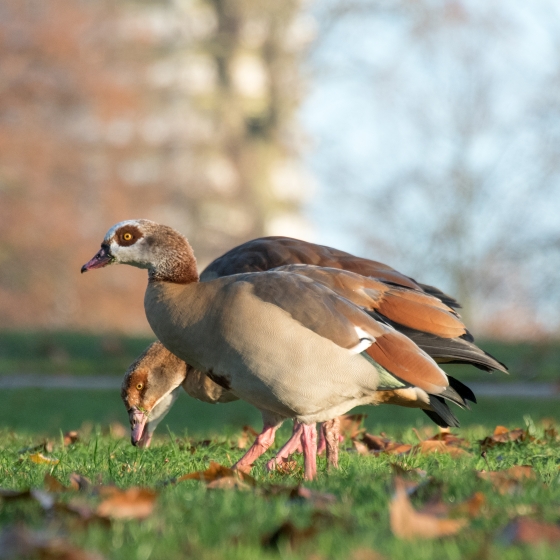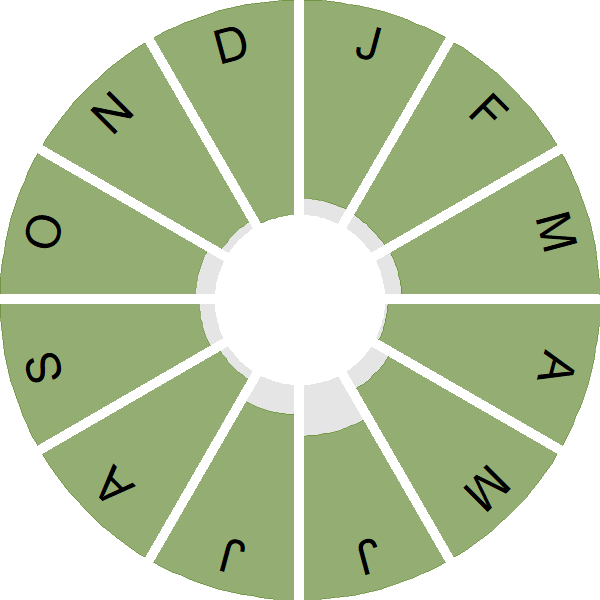Egyptian Goose

Introduction
The Egyptian Goose is a loud and rather striking goose, most familiar to birdwatchers in East Anglia and the south-east of England.
This 17th century introduction to England has only relatively recently shown significant expansion in its numbers and distribution. In 1991 the population was estimated at c.900 individuals, 91% of which were in Norfolk. Since then, the species has colonised the rest of East Anglia, much of London and parts of the Home Counties. Expansion into the East Midlands is the likely next step.
Egyptian Geese breed very early in the year, and favour large old trees with suitable cavities for nesting. With the male in attendance close by during incubation, breeding pairs are readily found.

Key Stats
Identification
Songs and Calls
Call:
Flight call:
Status and Trends
Conservation Status
Population Change
This non-native species originally established a self-sustaining population in Nofolk, but has increased both its range and its population over the last 50 years. A second core population has been established around Greater London with scattered records elsewhere in the south and east (see Atlas maps), and it is now sufficiently widespread that the short-term trend can be measured by BBS, with the ten-year trend graph confirming the rapid increase in numbers. Expanding populations of geese, including non-native Canada Geese, are creating a number of economic, social and environmental challenges and, increasingly, adaptive policies are required to manage invasive goose populations in order to minimise and mitigate economic and environmental impacts (e.g. Reyns et al. 2018).
Distribution
The distribution maps show that Egyptian Geese are now found in two main areas: East Anglia and an area centred on Greater London extending into parts of neighbouring counties. There is a suggestion that the East Midlands may develop into a third stronghold area, with a wide scattering of records there in both seasons. Away from these key areas there are isolated records as far north as Shetland, west Wales, southwest England and Ireland, with most of these records in winter.
Occupied 10-km squares in UK
2007/08–10/11
or view it on Bird Atlas Mapstore.
2008–11
or view it on Bird Atlas Mapstore.
European Distribution Map
Distribution Change
The reason for the expansion over the last 20 years is unknown, though is probably fuelled by an increasing population in East Anglia leading to wider dispersal.
Change in occupied 10-km squares in the UK
from 1981–84 to 2007–11
or view it on Bird Atlas Mapstore.
from 1968–72 to 2008–11
or view it on Bird Atlas Mapstore.
Seasonality
Egyptian Geese can be seen throughout the year in parts of southern and eastern England.
Weekly pattern of occurrence
The graph shows when the species is present in the UK, with taller bars indicating a higher likelihood of encountering the species in appropriate regions and habitats.

Movement
Britain & Ireland movement
Foreign locations of birds ringed or recovered in Britain & Ireland
Dots show the foreign destinations of birds ringed in Britain & Ireland, and the origins of birds ringed overseas that were subsequently recaptured, resighted or found dead in Britain & Ireland. Dot colours indicate the time of year that the species was present at the location.
- Winter (Nov-Feb)
- Spring (Mar-Apr)
- Summer (May-Jul)
- Autumn (Aug-Oct)

European movements
EuroBirdPortal uses birdwatcher's records, such as those logged in BirdTrack to map the flows of birds as they arrive and depart Europe. See maps for this species here.
The Eurasian-African Migration Atlas shows movements of individual birds ringed or recovered in Europe. See maps for this species here.
Biology
Productivity and Nesting
Nesting timing
Egg measurements
Clutch Size
Survival and Longevity
Survival is shown as the proportion of birds surviving from one year to the next and is derived from bird ringing data. It can also be used to estimate how long birds typically live.
View number ringed each year in the Online Ringing Report.
Lifespan
Biometrics
Wing length and body weights are from live birds (source).
Ring Size
Classification, names and codes
Classification and Codes
- Order: Anseriformes
- Family: Anatidae
- Scientific name: Alopochen aegyptiaca
- Authority: Linnaeus, 1766
- BTO 2-letter code: EG
- BTO 5-letter code: EGYGO
- Euring code number: 1700
Alternate species names
- Catalan: oca d'Egipte
- Czech: husice nilská
- Danish: Nilgås
- Dutch: Nijlgans
- Estonian: vaaraohani
- Finnish: afrikanhanhi
- French: Ouette d’Égypte
- German: Nilgans
- Hungarian: nílusi lúd
- Icelandic: Nílarönd
- Italian: Oca egiziana
- Latvian: Nilas / Egiptes zoss
- Lithuanian: egiptine žasis
- Norwegian: Niland
- Polish: kazarka egipska
- Portuguese: ganso-do-egipto
- Slovak: húska štíhla
- Slovenian: nilska gos
- Spanish: Ganso del Nilo
- Swedish: nilgås
- Welsh: Gwydd yr Aifft
Research
Causes of Change and Solutions
Causes of change
There is little good evidence available regarding the drivers of the breeding population increase in this species in the UK. However, the growth matches that of both Canada Goose and Greylag Goose and it is likely that the initial rapid increases following introduction was driven by similar factors. Factors behind its success in the Netherlands may have included the climate, the wide availability of suitable good quality grassland habitat and the fact that it has few natural enemies there (Gyimesi & Lensink 2010).
More Evidence
More evidence from Conservation Evidence.com
Partners
Citing BirdFacts
If you wish to cite particular content in this page (e.g. a specific value) it is best to use the original sources as linked in the page. For a more general citation of the whole page please use: BTO (20XX) BirdFacts Species: profiles of birds occurring in the United Kingdom. BTO, Thetford (www.bto.org/birdfacts, accessed on xx/xx/xxxx).

